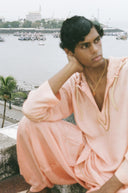Silk Road Summer Sale — Use code MIDSUMMER10 for 10% off all products
Mumbai, a metropolitan area with a rich history that has shaped South Asia, is the backdrop for The Silk Road’s Fall/Winter editorial campaign. The Silk Road’s curation delves into the legacy of Bombay, blending the old with the new, and showcasing how contemporary culture is evolving while remaining deeply rooted in its heritage. It also highlights a new generation that is taking the future of fashion into their own hands, presenting their creative identities to the world while supporting the local communities around them. These small pockets of creativity across continents are becoming the new birthplaces of global fashion and ushering in a new era for The Silk Road.


Once a bustling hub of trade along the maritime Silk Route, Mumbai’s history is woven with the exchange of textiles, spices, and culture between the East and West. Merchants on their journeys would have stopped in the city of dreams, admiring the raw coastlines of the Indian harbor, infused with the scents of nature, sea, and spices.
Mumbai is a city where colonial past and modern growth coexist, and one of the most striking examples of this is its English-inspired architecture. During British colonial rule ( 1858 - 1947) , Mumbai (then Bombay) was transformed into a major urban center, and the British left their architectural legacy across the city in the form of grand buildings that combined European and Indian styles. The British also established factories, merging Western techniques with Indian craftsmanship. This blend of European styles and Indian textiles not only marked the city as a global fashion player but also set the stage for future innovations in textile design.
As the city’s textile industry thrived, Mumbai found itself at the center of another cultural revolution—Bollywood. With the first film made in Mumbai in 1913, the city’s film industry would go on to define fashion for decades. During the Golden Era of the 1950s and 60s, Bollywood stars introduced styles that reflected both traditional Indian garments and modern Western influences, blending the two seamlessly.
As Mumbai’s fashion evolved, so did societal roles. Traditional attire began to reflect the changing gender dynamics in the city. Women moved from sarees to more comfortable and versatile options like the salwar kameez, while men adapted kurtas and trousers for everyday wear. The city’s fashion became a reflection of this balancing act.
This transition in fashion also mirrored the social changes brought by Mumbai’s textile boom. The influx of migrant workers during the late 19th and early 20th centuries led to the rise of chawls, affordable multi-storied buildings that housed the city’s textile laborers. These tight-knit communities, centered around textile work, became a vital part of Mumbai’s working-class identity. Though chawls are being redeveloped into high-rise apartments today, they remain a powerful symbol of the city’s industrial roots.


As the textile industry modernized, so too did the styles that Mumbai’s residents embraced. Denim, which made its debut in Mumbai in the 1960s, quickly caught on as a symbol of Western fashion. By the 1980s, local manufacturers began producing denim, making it widely accessible in the city’s markets. The 1990s saw denim’s popularity soar, as it became a staple of urban style. Mumbai's youth embraced the fabric, and by the early 2000s, denim had firmly established itself in both casual and formal wear.
Denim’s evolution in Mumbai also mirrors the city’s journey toward women’s empowerment. As women’s roles in society expanded, denim became a symbol of independence and modernity.
The evolution of transportation in Mumbai also shaped its textile and fashion industries. Early 20th-century street life, characterized by horse-drawn carriages and later motorized vehicles, reflected the rapid urbanization of the city. The men working long hours in this sector became a part of the growing workforce in textile mills. Over time, fashion in Mumbai adapted to this urban energy, with textiles evolving to suit the demands of modern life.
Mumbai’s fashion scene reflects a nuanced balance between tradition and modernity, particularly in how gender roles influence clothing choices. Traditionally, gender-specific attire such as sarees and kurtas represented cultural values and societal norms. However, as the city evolved, so did its approach to gender and fashion. Women in Mumbai began embracing a range of clothing options, from traditional sarees to contemporary Western wear, symbolizing their expanding roles in society. Simultaneously, men adapted their fashion choices to blend traditional kurtas with modern trousers and jackets, signifying a shift towards more versatile and inclusive attire.
Credits : Photographed by Anai Bharucha, styled by Samar Rajput, with hair and makeup by Umang. Featuring models Gauri Sharma, Pingal Tigga, and Nasir. The shoot was assisted by Reshma Mulik as Assistant Photographer, Paramita Rana as Assistant Hair & Makeup, and Aditya Kamal Singh as Assistant Stylist. Male models were provided by anon models, while the female models were sourced through Feat Artist. Hair and makeup were managed by Anima Creative.





















